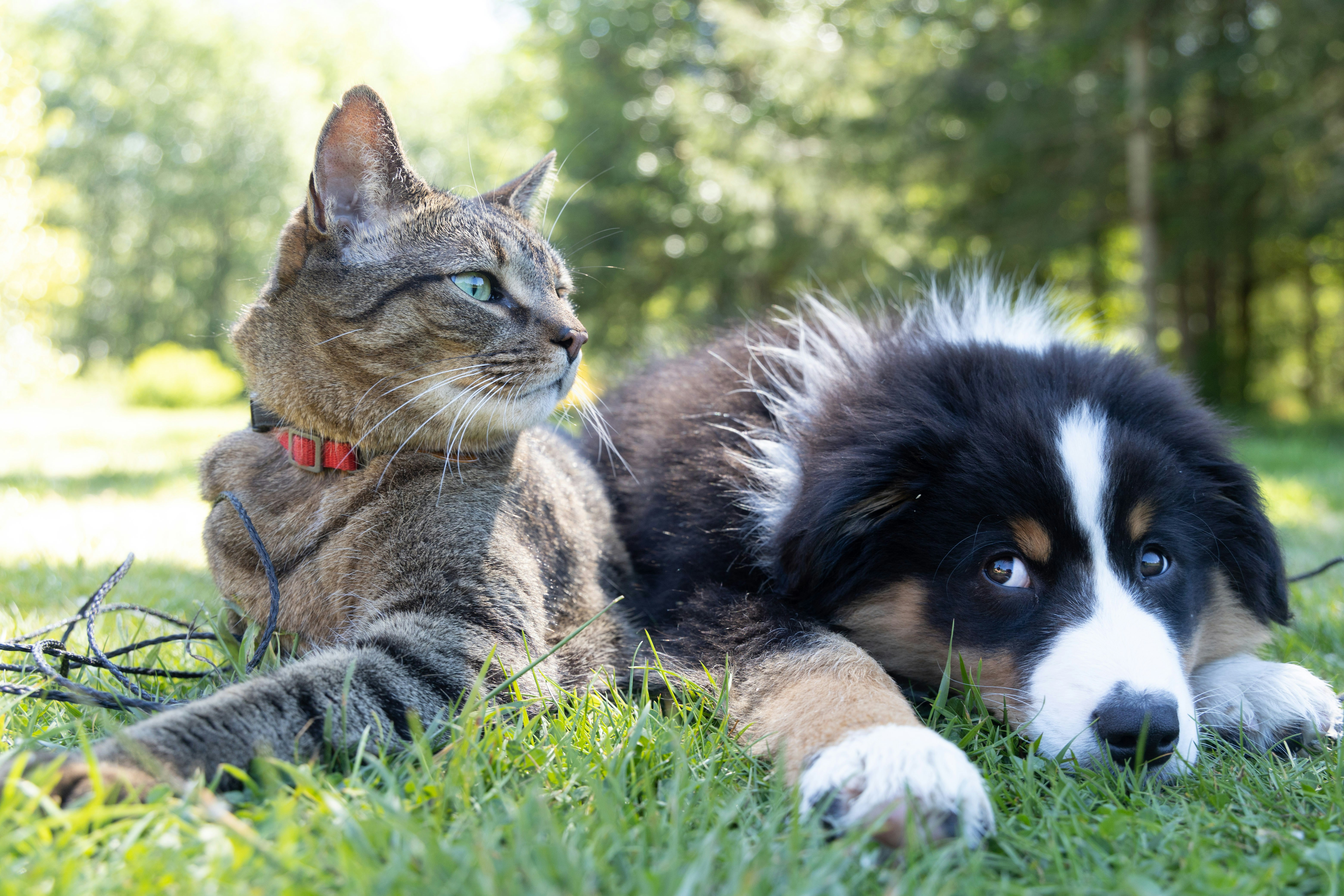
So you’ve decided to add a new furry member to your family in the form of an energetic puppy or a goofy senior dog. While this new addition will bring lots of joy to you, have you considered how your resident cat will feel? In the enchanting world of pet companionship, introducing your dog to a cat is a pivotal moment filled with anticipation, curiosity, and perhaps a hint of caution. In this guide, we'll explore the intricacies of this introduction, ensuring a harmonious coexistence between your furry friends.
Is your dog well-trained?
First things first, is your dog well-trained? And by trained, we mean can they obey the basic commands of ‘sit’, ‘stay’ and ‘leave it’. These dog manners are extremely important for an initial dog and cat meeting as a well-behaved canine is more likely to handle the introduction smoothly. Cats tend to like personal space which dogs typically ignore, so it’s vital that your dog can be introduced in a way that is respectful to your cat’s territory.
If your pup needs a refresher or is still learning the basics, take the time to reinforce these commands before the grand meeting. And be sure to take your dog on a high-energy walk prior to the introduction so they can be and feel more relaxed for everyone.
Perfect timing
Timing is everything, and introducing your dog to a cat is no exception. Your dog will likely feel a range of emotions upon their homecoming from excited to nervous. So be sure to make the initial introduction to your cat short, but sweet, and choose a moment when both pets are calm and relaxed. And avoid introducing them to one another during mealtime.
Patience is key for this meeting so let the introduction unfold at a natural pace. Your house is a new and possibly scary environment for your dog so give them time to get used to the new smells and surroundings. This may take anywhere from a couple of days to a week or more. Taking these steps will help your new furry friend settle in with ease and avoid unnecessary stress.
One way you can help your dog and cat get used to each other faster is through their distinct smells. By swapping their bedding before they meet, your dog will instinctively pick up on your cat’s scent on the cat bed and your cat will start to get to know your dog from the scents on the dog bed. And who knows, they may end up sharing beds all the time as time and friendships progress.
The right setting
Creating the right setting for your dog and cat meeting is crucial. Both animals are territorial in nature so it’s important to select a neutral territory where neither pet feels on guard. This neutral ground not only helps reduce potential tension, but also ensures a fair start to their relationship.
When introducing your new dog to your cat for the first time, avoid having too many people around. Young children or guests can make the initial meeting feel too overwhelming for both pets and the goal is for everyone to feel calm and relaxed. Keep the initial meeting short and sweet and then gradually extend their time together as they become more comfortable with one another.
Leave the lead on
For the safety of both pets, consider keeping your dog on a dog lead during the first encounter. This allows you to have better control over their movements and prevent any sudden or unwarranted interactions. With the lead on, your dog will better understand that it is not playtime and likely respond in a more controlled manner. Slowly gauge their reactions to one another and as both cat and dog feel relaxed, you can remove the lead.
Create a cat retreat
Cats love their personal space. So when introducing them to a new dog, it’s essential that you provide your cat with a safe retreat where they can feel calm and relaxed. The Maya Indoor Cat House, designed by Omlet is a perfect choice as it gives your feline friend a designated cosy spot they can call their own. And what cat wouldn’t want that?
Positive reinforcement
When it comes to encouraging positive interactions between your new dog and cat, one of the best courses of action is through treats, praise, and affection. It’s important to reward both pets for calm behaviour and moments of curiosity without aggression to reinforce good manners.
Should your dog or cat show any form of disobedience, avoid punishing them as that will only create a negative association with one another. And remember that cats can often take longer to warm up to new friends, so instant ignoring is not bad behaviour, just normal. Make the introduction a memorable and enjoyable experience for all by sticking to basic commands, creating a calm environment and praising the positive interactions.
Repeat
Rome wasn't built in a day, and neither is a perfect friendship between your dog and cat. For some cats and dogs, the introductions will go very smoothly and it may only take a couple of introductions before everyone feels happy. But for others, it may take multiple introductions per day over the course of several weeks before there’s a feeling of being settled.
Once you’ve reached the stage where your dog remains calm on the lead, the next step is to allow the two animals to interact off the lead, still ensuring that there’s always a personal retreat for your cat to go to. The most important thing is not to rush through the introductions. Some dogs need more time before they can be trusted with a cat, so repeat the introduction process gradually, allowing both pets to acclimate at their own pace. Consistency and repetition foster trust and understanding and will be invaluable for their coexistence together.
Potentials to expect
As your dog and cat start bonding, it’s essential that you anticipate various behaviours. While many first meetings can be easy and met with a mutual understanding, it’s important that you are prepared for any potential behaviours so you can react and accommodate accordingly.
Play: For dogs, the way to showcase a budding friendship is through playful activities. But for cats, this is not ideal and will most likely be interpreted as an attack, and responded to with claws and hisses. Because cats and dogs don’t share the same body language, follow the guidelines listed above for the best outcome for all.
Prey: Some breeds of dogs such as the German short-haired pointer or the foxhound have strong predator/prey instincts and will act aggressively by stalking the cat or staring at it, or simply diving in for the chase. This is where the “repeat” and “positive reinforcement” steps come in to help break this behaviour. Sometimes the instinct will be very difficult to break and you may never be able to leave your pets together unsupervised.
Avoidance: Be prepared that not every cat and dog care to be around each other. Sometimes your pets will simply base their relationship on avoiding each other - and that’s ok. Ignoring one another is normal and can provide a happy coexistence, however, always be sure to keep separation at nighttime to avoid the possibility of one animal becoming distressed by the mere presence of the other.
Kitten insights: When it comes to introducing a new dog to a kitten, best to wait. It’s a simple fact that dogs are by nature bigger than cats and often more powerful too. Natural instincts will always prevail so if you have a kitten at home, wait until they are of full maturity before introducing a dog to the family. This will ensure everyone is capable of handling a new relationship with comfort and ease.
Omlet and your pets
When it comes to pet companionship, Omlet truly understands the dynamics between cats and dogs. Our ingenious designs aim to enhance the lives of both pets and their humans as we continue to pave the way for a harmonious coexistence for everyone. From cosy dog beds to peaceful cat houses, Omlet provides products that cater to the unique needs of all your furry companions. Here's to a lifetime of joy, laughter, and new friendships.



Comments
There are no comments just yet